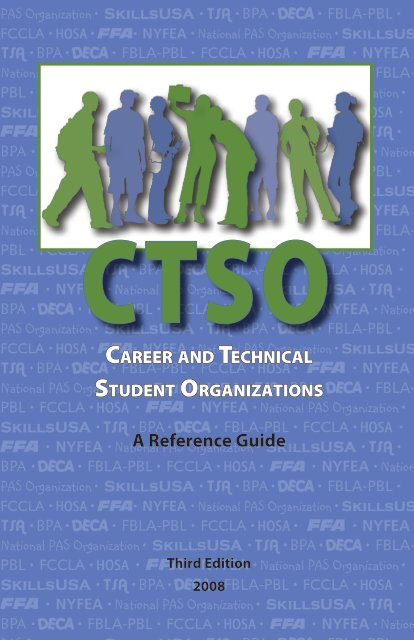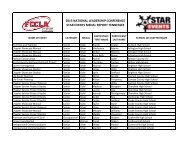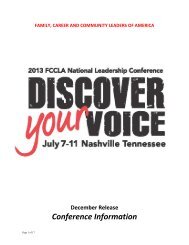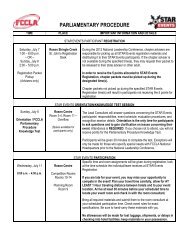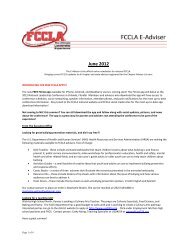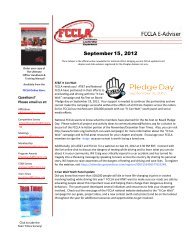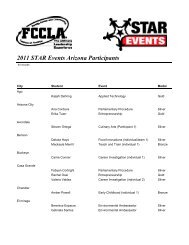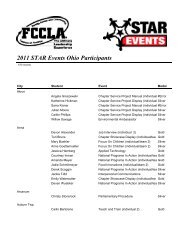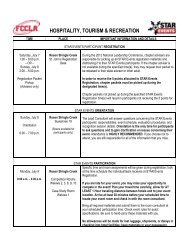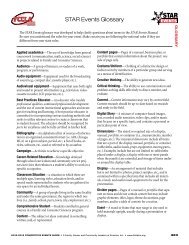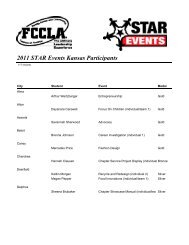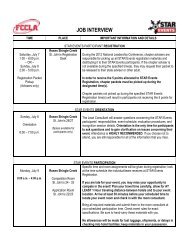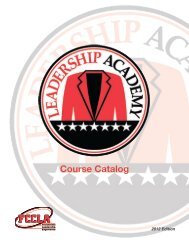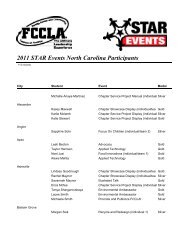CTSO Guide.pdf
CTSO Guide.pdf
CTSO Guide.pdf
You also want an ePaper? Increase the reach of your titles
YUMPU automatically turns print PDFs into web optimized ePapers that Google loves.
<strong>CTSO</strong><br />
Ca r e e r a n d Te C h n i C a l<br />
ST u d e n T Or g a n i z a T i O n S<br />
A Reference <strong>Guide</strong><br />
Third Edition<br />
2008
The <strong>CTSO</strong>s gratefully acknowledge the contributions of the following<br />
people who were instrumental in the creation of this guide:<br />
Editor/Project Manager: Lyn Fiscus<br />
Leadership Logistics<br />
Contributing Editor/Writer: Alisha Dixon Hyslop<br />
Assistant Director of Public Policy,<br />
Association for Career and Technical<br />
Education
Ca r e e r a n d Te C h n i C a l<br />
ST u d e n T Or g a n i z a T i O n S<br />
A Reference <strong>Guide</strong><br />
Third Edition<br />
2008
CO n T e n T S<br />
Section 1: Historical Overview of <strong>CTSO</strong>s .................................1<br />
Overview of Legislation ......................................................1<br />
<strong>CTSO</strong>s Today ........................................................................3<br />
The National Coordinating Council for Career and<br />
Technical Student Organizations (NCC-<strong>CTSO</strong>) ............4<br />
Section 2: <strong>CTSO</strong> Links to Federal Programs ............................5<br />
State Leadership Activities ..................................................5<br />
Local Leadership Activities .................................................7<br />
Section 3: Overview of the <strong>CTSO</strong>s .............................................9<br />
Business Professionals of America .....................................9<br />
DECA.....................................................................................11<br />
FBLA–PBL ............................................................................13<br />
FCCLA...................................................................................15<br />
HOSA ....................................................................................18<br />
National FFA Organization ................................................19<br />
NYFEA ..................................................................................21<br />
National PAS Organization .................................................23<br />
SkillsUSA...............................................................................23<br />
TSA ........................................................................................26<br />
Section 4: Role of the National, State, and Local <strong>CTSO</strong> ..........29<br />
The National <strong>CTSO</strong> .............................................................29<br />
The State <strong>CTSO</strong> ....................................................................29<br />
The Local <strong>CTSO</strong> ...................................................................31<br />
State Authorities for Career and Technical Education ....33<br />
Section 5: Appendix<br />
NASDCTEC Statement of Policy: Career and Technical<br />
Student Organizations .........................................................36<br />
OVAE Letter..........................................................................38
1<br />
hiSTOriCal<br />
Ov e r v i e w O f <strong>CTSO</strong>S<br />
The concept of an organization designed to support students<br />
learning a vocation has its roots in the activities of such institutions<br />
as trade guilds and apprenticeship societies common<br />
in the 18th and 19th centuries. In more contemporary history,<br />
the development of career and technical education (formerly<br />
vocational education) and the career and technical student<br />
youth organization (formerly vocational student organization)<br />
can be chronicled through a number of relevant Federal laws.<br />
The information below outlines the federal role in career and<br />
technical education from current law back to its inception in<br />
1917.<br />
Carl D. Perkins Vocational and Technical<br />
Education Act of 2006<br />
The 2006 Perkins Act, an updated version of earlier Perkins<br />
laws passed in 1998, 1990, and 1984, is the vehicle for providing<br />
federal support for career and technical education. The<br />
Perkins Act provides resources to secondary and postsecondary<br />
career and technical education programs to support innovation<br />
and program improvement. States receive Basic State<br />
Grant funding that is then distributed to eligible recipients,<br />
including high schools, area career and technical schools, and<br />
community and technical colleges. The new act provides an<br />
increased focus on the academic achievement of career and<br />
technical education students, strengthens the connections between<br />
secondary and postsecondary education, and improves<br />
state and local accountability. The Perkins Act specifically<br />
1
includes career and technical student organization activities as<br />
allowable use of funds at the state and local level.<br />
Vocational Educational Act of 1963<br />
This act and its subsequent amendments of 1968 and 1976<br />
specified that vocational student organizations were an essential<br />
part of vocational instruction; vocational education, therefore,<br />
became a legitimate recipient of federal and state grant<br />
funds for the purpose of providing leadership and support to<br />
vocational student organizations and applicable and appropriate<br />
activities. (Hale, 1990.)<br />
Public Law 81-740 (1950)<br />
This law, referred to as Public Law 740, federally chartered a<br />
vocational student organization, thereby establishing the relationship<br />
of a vocational student organization to industrial arts<br />
education. It also officially tied the U.S. Office of Education to<br />
vocational student organizations by allowing employees of the<br />
U.S. Office of Education to be hired for the purpose of working<br />
with student organizations. Although this law chartered<br />
only one student organization (the vocational agriculture<br />
student organization), it established the pattern of treating<br />
existing and future vocational student youth organizations as<br />
integral parts of vocational education. (Hale, 1990.)<br />
“George Acts”<br />
These acts (1929, 1934, 1936, and 1946) were a series of laws<br />
that supplemented and continued the appropriations for<br />
vocational education started by the Smith-Hughes Act. Of<br />
the four acts, the most important to youth organizations was<br />
the George-Barden Act of 1946, also known as the Vocational<br />
Education Act of 1946. This act was the first to mention a<br />
vocational student organization by name, and it specifically<br />
stated that funds could be used for vocational agriculture<br />
teacher activities that were related to the vocational agriculture<br />
2
student organization. (Hale, 1990.)<br />
Smith-Hughes Act (1917)<br />
This act, often referred to as the “Granddaddy Act” of vocational<br />
education, provided the foundation for vocational<br />
student organizations. Although the act did not specifically<br />
mention student organizations, it provided funds for vocational<br />
agriculture teachers whose duties included advising and<br />
supervising a vocational student organization. (Hale, 1990.)<br />
<strong>CTSO</strong>s Today<br />
Today, the career and technical student organization (<strong>CTSO</strong>)<br />
is regarded as an integral part of career and technical education.<br />
<strong>CTSO</strong>s play an important part in preparing young people<br />
to become productive citizens and to assume roles of leadership<br />
in their communities. These organizations provide a<br />
unique program of career and leadership development, motivation,<br />
and recognition for secondary and post-secondary<br />
students enrolled, or previously enrolled, in career and technical<br />
education programs.<br />
Educators have found that the <strong>CTSO</strong> is a powerful instructional<br />
tool that works best when it is integrated into the career<br />
and technical education curriculum by a trained professional.<br />
The dedicated instructor provides organized curriculum-oriented<br />
activities that help students gain career, leadership, and<br />
personal skills that maximize employability and the ability to<br />
become productive citizens in the workforce, home, and community.<br />
Ten <strong>CTSO</strong>s are widely recognized:<br />
• Business Professionals of America (BPA)<br />
• Distributive Education Clubs of America (DECA)<br />
• Future Business Leaders of America–Phi Beta Lambda<br />
(FBLA–PBL)<br />
• Family, Career and Community Leaders of America (FCCLA)<br />
• Health Occupations Students of America (HOSA)<br />
3
• National FFA Organization (FFA)<br />
• National Young Farmer Educational Association (NYFEA)<br />
• National Postsecondary Agricultural Student (PAS) Organization<br />
• SkillsUSA (formerly Vocational Industrial Clubs of America)<br />
• Technology Student Association (TSA)<br />
The National Coordinating Council for Career and<br />
Technical Student Organizations (NCC-<strong>CTSO</strong>)<br />
The members of the National Coordinating Council for<br />
Career and Technical Student Organizations (NCC-<strong>CTSO</strong>)<br />
are the executive directors of the nationally recognized <strong>CTSO</strong>s<br />
and representatives of supportive organizations, including:<br />
• Association for Career and Technical Education<br />
• National Association of State Directors of Career Technical<br />
Education Consortium<br />
The mission of the council is threefold:<br />
(1) to identify and coordinate activities that are mutually beneficial<br />
to career and technical student organizations and their<br />
members<br />
(2) to share information that will enhance the development of<br />
career and technical education students<br />
(3) to strengthen career and technical education.<br />
Sources for this section:<br />
Hale, Karen J., The National Association of the Vocational Industrial Clubs of America: Development<br />
of a National Organization, 1965–1990. Ph.D, diss., University of Akron, 1990,<br />
202–213.<br />
Analysis of Relationship of U.S. Office of Education and Vocational Student Organizations.<br />
Vocational Industrial Clubs of America, 1977.<br />
The Perkins Act of 2006: The Official <strong>Guide</strong>. Association for Career and Technical Education,<br />
2006.<br />
4
2<br />
<strong>CTSO</strong> li n k S T O<br />
fe d e ra l Pr O g r a m S<br />
Since President Woodrow Wilson signed the first national<br />
vocational education act in 1917, the federal government has<br />
provided funding for vocational education. (Over the years,<br />
vocational education has evolved into career and technical<br />
education.) The initial modest investment in 1917 of approximately<br />
$7 million now has grown to more than $1.2 billion.<br />
The Carl D. Perkins Career and Technical Education Act of<br />
2006 (otherwise known as the Perkins Act) provides funding<br />
for career and technical education through fiscal year 2012.<br />
The Act specifies required and permissible uses of these funds<br />
for activities at the local and state levels. The following listing<br />
highlights some of these required and permissible uses of<br />
funds and describes how <strong>CTSO</strong>s might help to successfully<br />
carry out these activities.<br />
State Leadership Activities<br />
This section of the Perkins Act details 9 required and 17 permissible<br />
uses of leadership funds. <strong>CTSO</strong> activities fit in many<br />
of these required and permissible uses.<br />
Required Use of Funds<br />
n Professional development programs—Each <strong>CTSO</strong>, as part of<br />
its national and regional meeting program, provides professional<br />
development opportunities for teachers and advisors.<br />
To qualify as professional development, workshops and inservice<br />
training must be high quality, sustained, intensive, and<br />
classroom-focused; help improve student achievement; help<br />
5
teachers stay current with the needs, expectations, and methods<br />
of industry; and help develop rigorous and challenging<br />
integrated curricula, among other requirements.<br />
n Support for career and technical education programs that<br />
improve academic, and career and technical skills of students—<br />
<strong>CTSO</strong>s provide a venue for hands-on, contextual learning of<br />
classroom curriculum and help students see the “real world”<br />
value of what they study in their academic classes. Students<br />
have the opportunity in work settings to use career skills they<br />
have learned in the classroom.<br />
n Support for forging partnerships among local education agencies,<br />
postsecondary institutions, adult education providers, and<br />
other entities such as employers, labor organizations, intermediaries,<br />
and parents—<strong>CTSO</strong>s promote dialogue among relevant<br />
groups for the purpose of fostering partnerships and unified<br />
support for the career and technical education program.<br />
Permissible Use of Funds<br />
n Career guidance and counseling programs—Each <strong>CTSO</strong> has<br />
programs that supplement and complement the curriculum of<br />
its specific discipline. Through their work with guidance counselors,<br />
<strong>CTSO</strong>s provide a valuable component to the career<br />
guidance process.<br />
n <strong>CTSO</strong>s—Depending on the requirements within a specific<br />
state, it is possible that funds may be used to support activities<br />
of <strong>CTSO</strong>s, including travel for chapter advisors and students,<br />
and the purchase of instructional materials. Federal funds<br />
granted to <strong>CTSO</strong>s must be used to improve the career and<br />
technical education program.<br />
n Education and business partnerships—<strong>CTSO</strong>s provide<br />
students with opportunities to work with local businesses, in<br />
cooperative programs and through job shadowing.<br />
6
Local Leadership Activities<br />
While Perkins funds are distributed to school districts and<br />
community colleges through a prescribed formula based on<br />
factors such as poverty and population, how the funds are<br />
used once they get to the local level is different in every community.<br />
The federal law includes several required uses of funds<br />
and lists many permissible uses of funds. In reviewing these<br />
activities, you will see a broad array of possibilities for ways in<br />
which <strong>CTSO</strong>s can participate in the Perkins Act.<br />
Required Use of Funds<br />
n Strengthen academic and career and technical skills of students<br />
through integration of academic and career and technical<br />
programs—<strong>CTSO</strong> programs enhance both academic, and<br />
career and technical education course work. Through handson,<br />
contextual learning experiences, classroom lessons become<br />
more relevant for students by providing a “real world” value.<br />
n Provide programs that address all aspects of an industry—<br />
Through job shadowing and cooperative programs, students<br />
have the opportunity to learn about varied aspects of an industry.<br />
Permissible Use of Funds<br />
n Involve parents, businesses, and labor organizations in planning,<br />
implementing, and evaluating CTE programs—Parents of<br />
<strong>CTSO</strong> student members frequently get involved as chaperones,<br />
event judges, or sponsors of <strong>CTSO</strong> activities; also, through<br />
<strong>CTSO</strong> programs, students are exposed to business and labor<br />
leaders in their communities. A natural consequence of adult/<br />
student interaction through <strong>CTSO</strong>s is increased support for<br />
career and technical education.<br />
n Provide career guidance and academic counseling—The mission<br />
of each <strong>CTSO</strong> includes career guidance for its members.<br />
n Assist career and technical student organizations—Depend-<br />
7
ing on the requirements within a specific state or local school<br />
district, it is possible that funds may be available to support<br />
<strong>CTSO</strong> activities, such as travel for chapter advisors and students,<br />
or the purchase of instructional materials.<br />
8
3<br />
Ov e r v i e w O f<br />
T h e <strong>CTSO</strong>S<br />
The responsibility for CTE instructional programs and related<br />
activities, including <strong>CTSO</strong>s, rests with state and local education<br />
agencies. The United States Department of Education<br />
allows states to use Federal Carl D. Perkins funds to provide<br />
leadership and support for the CTE student organizations.<br />
Business Professionals of America<br />
Year founded: 1966<br />
Membership divisions: Secondary, Post-secondary, Middle<br />
Level<br />
Total annual membership: 50,000+<br />
States with chapters: AK, DE, FL, ID, IL, IN, IA, KS, LA,<br />
MA, MI, MN, MT, NM, NY, NC,<br />
OH, OK, RI, TN,TX, VT, WI<br />
Local chapters: 3000+<br />
International chapters: N/A<br />
Applicable course work:<br />
Accounting, Administrative Support, Office Systems/<br />
Procedures, Computer Security, Word Processing,<br />
Banking & Finance, Database Applications, Desktop<br />
Publishing, Digital Media, Economics, Entrepreneurship,<br />
Financial Analysis, Financial Math, Computer<br />
Programming, XHTML, Global Marketing, Graphic<br />
Design, Human Resource Management, Legal Office<br />
Procedures, Medical Office Procedures, Network Design,<br />
Parliamentary Procedure, PC Servicing, Presenta-<br />
9
tion Management, Small Business Management, Software<br />
Engineering, Spread Sheet Applications, Video<br />
Production, Web Applications, Web Site Design<br />
Focus areas of chapters: Co-curricular business/IT learning,<br />
competition, leadership/professional<br />
development, community service<br />
Competitive program levels: Secondary, Post-secondary,<br />
Middle Level<br />
Future national conferences:<br />
Reno, NV, May 7–11, 2008<br />
Dallas, TX, May 6–10, 2009<br />
Anaheim, CA, May 5–9, 2010<br />
Washington, DC, May 4–8, 2011<br />
Chicago, IL, April 25–29, 2012<br />
Conference participants: 5,000+<br />
Mission statement/goals:<br />
To contribute to the preparation of a world-class<br />
workforce through the advancement of leadership,<br />
academic, citizenship, and technological skills; prepare<br />
students to be effective associates and committed business<br />
leaders by educating, validating, and motivating<br />
on an individual basis; to develop the business, communication,<br />
technical, and leadership skills needed to<br />
contribute and compete in the workplace today and<br />
tomorrow.<br />
The organization’s ties to curricula:<br />
Works with curriculum publishers and a classroom<br />
educator advisory council<br />
Executive Director: Kirk W. Lawson<br />
Address: 5454 Cleveland Ave.<br />
Columbus, OH 43231-4021<br />
10
Phone: 614-895-7277<br />
E-mail: klawson@bpa.org<br />
Website: www.bpa.org<br />
DECA—An Association of Marketing Students<br />
Year founded: 1946<br />
Membership divisions: High School (marketing education<br />
in secondary institutions); Delta<br />
Epsilon Chi (marketing education in<br />
technical and post-secondary institutions);<br />
Professional (educators and<br />
administrators); Alumni (former<br />
high school and Delta Epsilon Chi<br />
members)<br />
Total annual membership: 201,000<br />
States with chapters: 50 plus District of Columbia, Guam,<br />
Puerto Rico<br />
Local chapters: 6,000<br />
International chapters: Canada, Germany, Mexico<br />
Applicable course work: Marketing/Administration and<br />
Management/Finance/ Hospitality<br />
Focus area of chapters: Career and professional development,<br />
community service, leadership<br />
skills<br />
Competitive program levels: Local, state, regional, national<br />
Future national conferences:<br />
Anaheim, CA, April 29–May 2, 2009<br />
Louisville, KY, April 24–27, 2010<br />
Orlando, FL, April 30–May 3, 2011<br />
Salt Lake City, UT, April 28–May 1, 2012<br />
11
Conference Participants: 15,000 per conference<br />
Mission Statement/Goals:<br />
The mission of this organization is to enhance the cocurricular<br />
education of students who have an interest<br />
in marketing, management, and entrepreneurship.<br />
DECA seeks to help students develop skills and<br />
competence for marketing, finance, hospitality,<br />
management, and entrepreneurial careers, build selfesteem,<br />
experience leadership, and practice community<br />
service. DECA is committed to the advocacy and<br />
the growth of business and education partnerships.<br />
The organization’s ties to curricula:<br />
DECA supports and contributes to classroom learning<br />
through its co-curricular materials and chapter activities<br />
such as mentor training, structured work plans,<br />
and competitive events (including classroom projects<br />
that simulate real-life business situations). DECA<br />
provides educators with a means to measure student<br />
growth and the attainment of identifiable career skill<br />
competencies. DECA rewards and recognizes its<br />
student members, thus increasing their motivation and<br />
self-esteem. DECA is a viable link between business<br />
and education.<br />
Executive Director: Dr. Edward L. Davis<br />
Address: DECA Inc., 1908 Association Drive,<br />
Reston, VA 20191-1594<br />
Phone: 703-860-5000<br />
Fax: 703-860-4013<br />
E-mail: decainc@aol.com<br />
Website: www.deca.org<br />
12
Future Business Leaders of America–Phi Beta<br />
Lambda (FBLA–PBL)<br />
Year founded: 1942<br />
Membership divisions: Future Business Leaders of America<br />
(high school); FBLA-Middle Level;<br />
Phi Beta Lambda (PBL) (postsecondary);<br />
Professional Division (alumni<br />
and professional community)<br />
Total annual membership: 250,000<br />
States with chapters: 46, plus District of Columbia,<br />
DoDDS Europe, Mariana Islands,<br />
U.S. Virgin Islands, Puerto Rico<br />
Local chapters: 6,000+<br />
International chapters: Bermuda, Canada, Cayman Islands<br />
Applicable course work: Entrepreneurship, Finance, Management,<br />
Marketing, Computer Applications,<br />
Networking, Programming,<br />
Communications, Web, Ethics, and<br />
basic business<br />
Focus areas of chapters: Leadership, Entrepreneurship, Career<br />
Development, Community Service,<br />
Communications, Business Partnerships,<br />
Technology<br />
Competitive program levels: Local, District/Regional, State,<br />
National<br />
Future national conferences:<br />
Atlanta, GA, June 26–29, 2008<br />
Minneapolis, MN, November 7–8, 2008<br />
Washington, DC, November 14–15, 2008<br />
Phoenix, AZ, November 21–22, 2008<br />
New Orleans, LA, November 21–22, 2008<br />
13
Anaheim, CA, June 25–28, 2009<br />
Nashville, TN, July 14–17, 2010<br />
Conference participants: 15,000<br />
Mission statement/goals:<br />
Our mission is to bring business and education together<br />
in a positive working relationship through innovative<br />
leadership and career development programs.<br />
The organization’s ties to curricula:<br />
The activities, programs, and competitions endorsed<br />
by FBLA–PBL, Inc., correspond to and are co-curricular<br />
with the approved business syllabi of state<br />
departments of education, correlate with the National<br />
Standards for Business Education as put forth by the<br />
National Business Education Association (NBEA) and<br />
the U.S. Department of Education Career Clusters.<br />
FBLA–PBL is committed to facilitating the transition<br />
of its members from their educational development<br />
into their career paths. FBLA–PBL allows members<br />
to demonstrate and validate their mastery of essential<br />
business concepts, skills, and knowledge.<br />
President and CEO: Jean M. Buckley<br />
Address: 1912 Association Drive<br />
Reston, VA 20191-1591<br />
Phone: 703-860-3334<br />
Fax: 866-500-5610<br />
E-mail: General@fbla.org<br />
Website: www.fbla-pbl.org<br />
14
Family, Career and Community Leaders of<br />
America (FCCLA)<br />
Year founded: 1945<br />
Membership divisions: Middle level, high school, alumni<br />
and associates, and honorary<br />
Total annual membership: 220,000+<br />
States with chapters: 50, including District of Columbia,<br />
U. S. Virgin Islands, and Puerto Rico<br />
Local chapters: 7,000+<br />
International chapters: Future Homemakers of Japan, FHJ<br />
Applicable course work: Family and Consumer Sciences classes<br />
including human relations; food<br />
production services; early childhood<br />
development; textiles and apparel;<br />
housing, interiors and furnishings;<br />
hospitality; financial literacy; health<br />
and nutrition; and tourism and recreation<br />
Focus areas of chapters: Career Connection, Community Service,<br />
Families Acting for Community<br />
Traffic Safety (FACTS), Families First<br />
(family relations), Financial Fitness,<br />
STOP the Violence (Students Taking<br />
On Prevention), Student Body (nutrition<br />
and fitness), and various leadership<br />
programs and opportunities<br />
Competitive program levels:<br />
STAR Events (Students Taking Action with Recognition)<br />
are competitive events in which members are<br />
recognized for proficiency and achievement in chapter<br />
and individual projects, leadership skills, and career<br />
preparation. STAR Events offer individual skill devel-<br />
15
opment and application of learning through the following<br />
activities:<br />
• Cooperative—teams work to accomplish specific<br />
goals<br />
• Individualized—an individual member works alone<br />
to accomplish specific goals<br />
• Competitive—individual or team performance measured<br />
by an established set of criteria.<br />
Participants will receive national recognition items<br />
including achievement medals, certificates, and a press<br />
release for local media. Recognition levels are: Gold<br />
Medal (Highest level); Silver Medal; Bronze Medal<br />
Future national conferences:<br />
National Leadership Conferences:<br />
• Nashville, TN, July 12–16, 2009<br />
• Chicago, IL, July 4–8, 2010<br />
• Anaheim, CA July 10–14, 2011<br />
National Cluster Meetings: Held across the country<br />
each November.<br />
Conference participants: 1,000–5,500<br />
Mission statement/goals:<br />
FCCLA’s mission is to promote personal growth and<br />
leadership development through Family and Consumer<br />
Sciences education. Focusing on the multiple roles<br />
of family member, wage earner, and community leader,<br />
members develop skills for life through character<br />
development, creative and critical thinking, interpersonal<br />
communication, practical knowledge, and career<br />
preparation. Our goals are:<br />
• To provide opportunities for personal development<br />
and preparation for adult life<br />
16
• To strengthen the function of the family as a basic<br />
unit of society<br />
• To encourage democracy through cooperative action<br />
in the home and community<br />
• To encourage individual and group involvement in<br />
helping achieve global cooperation and harmony<br />
• To promote greater understanding between youth<br />
and adults<br />
• To provide opportunities for making decisions and<br />
for assuming responsibilities<br />
• To prepare for the multiple roles of men and women<br />
in today’s society<br />
• To promote Family and Consumer Sciences and<br />
related occupations<br />
The organization’s ties to curricula:<br />
FCCLA students plan, carry out, and evaluate projects<br />
and activities that achieve leadership development and<br />
success. The “end products” (portfolios, project reports,<br />
recognition) offer relevant and authentic means<br />
to assess student learning. FCCLA is an integral part of<br />
the Family and Consumer Sciences education program.<br />
In local schools, chapter projects and activities<br />
stem from and enhance Family and Consumer Sciences<br />
programs of study. FCCLA chapters give students<br />
extended learning opportunities for knowledge<br />
application, leadership training, community involvement,<br />
and personal growth. FCCLA offers a variety<br />
of national programs to guide and motivate students as<br />
they develop projects of relevance and results.<br />
Executive Director: Michael L. Benjamin, M.P.H., CAE<br />
Address: 1910 Association Drive<br />
Reston, VA 20191<br />
17
Phone: 703-476-4900<br />
Fax: 703-860-2713<br />
E-mail: mbenjamin@fcclainc.org<br />
Website: www.fcclainc.org<br />
Health Occupations Students of America (HOSA)<br />
Year Founded: 1976<br />
Membership divisions: Secondary; Postsecondary/Collegiate;<br />
Professional; Alumni; Honorary;<br />
Members-at-Large; and, Middle<br />
School (beginning in 2008–09)<br />
Total annual membership: 95,500<br />
States with chapters: 47 including the District of Columbia<br />
and Puerto Rico<br />
Local chapters: 2,700<br />
International chapters: N/A<br />
Applicable course work: Health Science Education<br />
Focus areas of chapters: Career opportunities in the health<br />
care industry<br />
Competitive program levels: Local, state, regional, national<br />
Future national conferences:<br />
Dallas, TX, June 18–21, 2008<br />
Nashville, TN, June 24–27, 2009<br />
Orlando, FL, June 23–26, 2010<br />
Conference participants: 6,000 delegates, judges and Friends<br />
of HOSA of which 4,500 are competing<br />
in HOSA events<br />
Mission statement/goals:<br />
The mission of HOSA is to enhance the delivery of<br />
compassionate, quality health care by providing op-<br />
18
portunities for knowledge, skill, and leadership development<br />
of all health science technology education<br />
students, therefore, helping students to meet the needs<br />
of the health care community.<br />
The organization’s ties to curricula:<br />
HOSA is 100 percent curricular. All competitive events<br />
are designed with Health Science resources with<br />
content and rubrics approved by the health care<br />
industry.<br />
Executive Director: Dr. Jim G. Koeninger<br />
Address: HOSA National Headquarters,<br />
6021 Morriss Road, Suite 111<br />
Flower Mound, TX 75028<br />
Phone: 972-874-9962; 800-321-HOSA<br />
(4672)<br />
E-mail: hosa@hosa.org<br />
Website: www.hosa.org<br />
National FFA Organization<br />
Year founded: 1928<br />
Membership divisions: Active student members; Alumni<br />
Total annual membership: Student members: 500,823;<br />
Alumni: 45,399<br />
States with chapters: All 50 states, plus Puerto Rico and<br />
the U.S. Virgin Islands<br />
Local chapters: 7,358<br />
International chapters: None<br />
Applicable course work:<br />
FFA is an intra-curricular, not an extra-curricular<br />
activity. To be eligible for FFA membership, students<br />
19
must be enrolled in agricultural education classes<br />
through their schools. FFA also provides leadership<br />
development lessons and conferences to enable students<br />
of all ages and levels to pursue personal growth<br />
and leadership opportunities.<br />
Focus areas of chapters:<br />
Local chapters are encouraged to actively implement<br />
the mission and strategies of the organization, concentrating<br />
on three divisions: Student development,<br />
Chapter development, and Community development.<br />
The concept of “giving back” through community service<br />
and servant leadership is a key focus area of FFA<br />
chapters.<br />
Competitive program levels:<br />
FFA confers a series of degrees on its members who<br />
meet qualifying criteria. They are: Discovery Degree,<br />
Greenhand Degree, Chapter FFA Degree, State FFA<br />
Degree, and the highest degree FFA confers: The<br />
American FFA Degree. More than 3,000 members each<br />
year receive the American FFA Degree.<br />
In addition to these degrees, FFA provides competitive<br />
events including:<br />
• The National FFA Proficiency Award program, in<br />
which members can individually demonstrate their<br />
proficiency in key industry areas.<br />
• Career Development Events, in which members,<br />
individually or in teams, compete for national honors<br />
in areas ranging from public speaking to agricultural<br />
mechanics to forestry.<br />
Future national conferences:<br />
The National FFA Convention is the nation’s largest annual<br />
student gathering:<br />
20
• Indianapolis, IN, Oct. 22–25, 2008<br />
• Indianapolis, IN, Oct. 21–24, 2009<br />
• Indianapolis, IN, Oct. 20–23, 2010<br />
• Indianapolis, IN, Oct. 19–22, 2011<br />
• Indianapolis, IN, 2012 TBD<br />
Conference participants: 53,631 in 2007<br />
Mission statement/goals:<br />
The National FFA Organization is dedicated to making<br />
a positive difference in the lives of students by developing<br />
their potential for premier leadership, personal<br />
growth, and career success through agricultural education.<br />
The organization’s ties to curricula:<br />
FFA is an intra-curricular, not an extra-curricular<br />
activity. To be eligible for FFA membership, students<br />
must be enrolled in agricultural education classes<br />
through their schools.<br />
National FFA Advisor and CEO: Dr. Larry D. Case<br />
Address: National FFA Organization, 6060<br />
FFA Drive, Indianapolis, IN 46268<br />
Phone: 317-802-6060<br />
E-mail: contact Julie J. Adams<br />
jadams@ffa.org<br />
Website: www.ffa.org<br />
National Young Farmer Educational Association<br />
(NYFEA)<br />
Year founded: 1982<br />
Membership divisions: none; members range in age from 18<br />
years plus<br />
21
Total annual membership: 3,500<br />
States with chapters: 22<br />
Local chapters: 500<br />
Applicable course work: American agriculture education<br />
Focus areas of chapters: Leadership training, community<br />
service<br />
Competitive program levels: local, state, national<br />
Future national conferences:<br />
Baltimore, MD, Dec. 11–13, 2008<br />
Conference participants: 900<br />
Mission statement/goals:<br />
The mission of this organization is to promote the<br />
personal and professional growth of all people<br />
involved in agriculture. NYFEA strives to develop and<br />
provide educational and leadership opportunities to its<br />
membership and others. It provides a national framework<br />
to inspire personal achievement and strengthen<br />
agricultural leadership, the result of which may foster<br />
economic growth.<br />
The organization’s ties to curriculum:<br />
The NYFEA uses the venues of classroom instruction<br />
and distance learning to promote leadership training,<br />
agricultural awareness, and literacy in adult students<br />
throughout America’s rural and urban communities.<br />
Executive Vice President: Gordon Stone<br />
Address: NYFEA, P.O. Box 20326<br />
Montgomery, AL 36120<br />
Phone: 334-213-3276<br />
Fax: 334-213-0421<br />
E-mail: natloffice@nyfea.org<br />
Website: www.nyfea.org<br />
22
National Postsecondary Agricultural Student<br />
Organization (National PAS Organization)<br />
Year founded: 1980<br />
Membership divisions: Collegiate (postsecondary)<br />
Total annual membership: 1,300<br />
States with chapters: 18<br />
Local chapters: 56<br />
Applicable course work: Agriculture, agribusiness, horticulture,<br />
and natural resources<br />
Focus areas of chapters: Leadership and intellectual development,<br />
technological literacy, ethics,<br />
and education/industry relations<br />
Competitive program levels: Local, state, regional, national<br />
Future national conferences:<br />
Hershey, PA, March 11–14, 2009<br />
St. Louis, MO, March 10–13, 2010<br />
Conference participants: 750<br />
Mission statement/goals:<br />
The National Postsecondary Agricultural Student<br />
Organization provides opportunities for individual<br />
growth, leadership, and career preparation.<br />
The organization’s ties to curriculum:<br />
The National PAS Organization promotes activities<br />
that help its members make appropriate career choices,<br />
identify and acquire the technical skills needed for a<br />
successful career, and develop leadership and management<br />
skills.<br />
Executive Director: Jeff Papke<br />
Address: 6060 FFA Drive<br />
Indianapolis, IN 46278-1370<br />
23
Phone: 317-802-4350<br />
Fax: 317-802-5350<br />
E-mail: jpapke@nationalpas.org<br />
Website: www.nationalpas.org<br />
SkillsUSA<br />
Year founded: 1965 (formerly known as the Vocational<br />
Industrial Clubs of America)<br />
Membership divisions: High school (students); college/postsecondary<br />
(students); professional<br />
(educators and administrators); and<br />
alumni<br />
Total annual membership: 300,000+<br />
States with chapters: 50, plus Guam, Puerto Rico, and the<br />
U.S. Virgin Islands<br />
Local chapters: 15,000+<br />
International chapters: none<br />
Applicable course work: Technical, skilled, service, and health<br />
occupations education<br />
Focus areas of chapters: Program of work includes professional<br />
development, business partnerships,<br />
community service, public<br />
relations, and competitions in occupational<br />
and leadership areas<br />
Competitive program levels: Local, district, state, national,<br />
international (official U.S. representative<br />
to the WorldSkills Competition)<br />
Future national conferences:<br />
Kansas City, MO, June 21–27, 2009<br />
Kansas City, MO, June 20–26, 2010<br />
24
Kansas City, MO, June 19–25, 2011<br />
Kansas City, MO, June 24–30, 2012<br />
Kansas City, MO, June 23–29, 2013<br />
Kansas City, MO, June 22–28, 2014<br />
Moving to Louisville, KY, in 2015<br />
Conference participants: 14,000<br />
Mission statement/goals:<br />
SkillsUSA is an applied method of instruction for<br />
preparing America’s high performance workers in<br />
public career and technical programs. It provides quality<br />
education experiences for students in leadership,<br />
teamwork, citizenship, and character development. It<br />
builds and reinforces self-confidence, work attitudes,<br />
and communications skills. It emphasizes total quality<br />
at work: high ethical standards, superior work<br />
skills, life-long education, and pride in the dignity of<br />
work. SkillsUSA also promotes understanding of the<br />
free-enterprise system and involvement in community<br />
service.<br />
The organization’s ties to curricula:<br />
Through integrated curricula, competitive events, and<br />
leadership training activities, SkillsUSA ensures that<br />
the education of America’s skilled workers meets the<br />
demands of the ever-evolving workplace. The organization<br />
builds partnerships and opens communication<br />
between educators and employers. Its local chapter<br />
program promotes occupational, academic, and employability<br />
skill development. The Professional Development<br />
Program for high school students and the<br />
Career Skills Education Program for college students<br />
teach the essential workplace skills identified by employers<br />
and the U.S. Secretary of Labor’s Commission<br />
on Achieving Necessary Skills (SCANS). SkillsUSA<br />
25
also offers a series of 46 technical assessments through<br />
the Work Force Ready System (for more information<br />
visit www.workforcereadysystem.org).<br />
Executive Director: Timothy W. Lawrence<br />
Address: SkillsUSA, P.O. Box 3000<br />
Leesburg, VA 20177-0300<br />
Phone: 703-777-8810<br />
Fax: 703-777-8999<br />
E-mail: anyinfo@skillsusa.org<br />
Website: www.skillsusa.org<br />
Technology Student Association (TSA)<br />
Year founded: 1978 (formerly AIASA, American<br />
Industrial Arts Student Association)<br />
Membership divisions: High school, middle school<br />
Total annual membership: 150,000<br />
States with chapters: 47, District of Columbia<br />
Local chapters: 2,000<br />
International chapters: Scotland, Germany, and Peru<br />
Applicable coursework: STEM (science, technology, engineering,<br />
and mathematics) education<br />
Focus areas of chapters:<br />
Technological literacy and excellence through competitive<br />
event preparation and competition; leadership opportunities<br />
through chapter, state, and national officer programs;<br />
leadership training through the annual DuPont<br />
Leadership Academy as well as state level leadership<br />
training programs; community service opportunities<br />
through a national service project and/or local service<br />
project initiatives; White Star membership program<br />
26
ecognition of chapter members who demonstrate<br />
leadership through mentoring new chapters; Chapter<br />
Excellence Award program recognition of chapters<br />
that exceed membership requirements to provide an<br />
exemplary program; Gold/Silver/Bronze Achievement<br />
Award program designed to motivate and recognize<br />
student members for high effort in a school’s technology<br />
education program; the Technology Honor Society<br />
recognition of TSA members who excel in academics,<br />
leadership, and service to their school and community.<br />
Competitive program levels: High school, middle school<br />
Future national conferences:<br />
Denver, CO, June 2009<br />
Orlando, FL, June 2011<br />
Nashville, TN, June 2012<br />
Conference participants: 5,000<br />
Mission statement/goals:<br />
The Technology Student Association fosters personal<br />
growth, leadership, and opportunities in technology,<br />
innovation, design, and engineering. Members apply<br />
and integrate science, technology, engineering, and<br />
mathematics (STEM) concepts through co-curricular<br />
activities, competitive events, and related programs.<br />
TSA has identified the following goals to be achieved<br />
by the 2010/11 school year.<br />
• Ensure competitions focus on STEM principles and<br />
education standards.<br />
• Increase exposure of TSA through mutually beneficial<br />
relationships.<br />
• Define and create leadership programs that are<br />
unique to TSA.<br />
• Market TSA’s new image to maximize recognition.<br />
27
The organization’s ties to curricula:<br />
Directives at the federal and state levels focus on providing<br />
avenues for initiatives such as STEM (science,<br />
technology, engineering, and mathematics) education.<br />
TSA helps technology teachers meet the criteria for<br />
STEM education goals through an exciting program<br />
that includes technology activities, competitions,<br />
leadership, and teamwork for students. In addition,<br />
all TSA activities are correlated to the Standards for<br />
Technological Literacy, as set forth by the International<br />
Technology Education Association.<br />
TSA and F1 in Schools collaborate to provide the F1<br />
Challenge to promote high-technology engineering<br />
skills and teamwork. The F1 Challenge is open to<br />
middle and high school level students nationwide and<br />
internationally. F1 team members learn and work in<br />
CAD, CAM, and CNC programs as they perform various<br />
activities at each phase of the five-step process to<br />
design, analyze, make, test, and race the 1/20th scale<br />
F1 car.<br />
Executive Director: Dr. Rosanne T. White<br />
Address: 1914 Association Drive<br />
Reston, VA 20191-1540<br />
Phone: 703-860-9000<br />
Fax: 703-758-4852<br />
Website: www.tsaweb.org;<br />
E-mail: general@tsaweb.org<br />
28
4<br />
rO l e O f T h e na T i O n a l, ST a T e,<br />
a n d lO C a l <strong>CTSO</strong><br />
The Carl D. Perkins Career and Technical Education Act of<br />
2006 defines a <strong>CTSO</strong> as an organization for individuals enrolled<br />
in a career and technical education program that engages<br />
in career and technical education activities as an integral<br />
part of the instructional program. <strong>CTSO</strong>s operate on local,<br />
state, and national levels.<br />
The National <strong>CTSO</strong><br />
The national <strong>CTSO</strong> should:<br />
• Provide activities that are integral to the program area served<br />
by the <strong>CTSO</strong>s.<br />
• Offer leadership development opportunities to members at<br />
the local, district, state, regional, and/or national levels.<br />
• Conduct professional development programs for state advisors,<br />
local advisors, and teachers.<br />
• Develop a curriculum-based national program of work, including<br />
materials and competitive events, designed to recognize<br />
excellence in performance.<br />
• Maintain a public awareness and outreach program that will<br />
project a positive and professional image of the <strong>CTSO</strong> to<br />
promote the value of career and technical education.<br />
• Serve as a national advocate for career and technical education<br />
with public policy makers, business and industry leaders,<br />
and the general public.<br />
The State <strong>CTSO</strong><br />
At the state level, <strong>CTSO</strong>s share the mission and purpose<br />
29
of their respective national organizations. The state <strong>CTSO</strong><br />
should:<br />
• Manage the operation of the state <strong>CTSO</strong> in a manner consistent<br />
with state/national constitutions and bylaws, within state<br />
policy guidelines.<br />
• Maintain linkages and collaborative efforts with teachers.<br />
• Help recruit chapter advisors and student members.<br />
• Plan and implement programs that support the career and<br />
technical education curriculum.<br />
• Adopt sound fiscal and organizational practices that ensure<br />
accountability.<br />
Recommended responsibilities of the state <strong>CTSO</strong>:<br />
• Manage the operation of the state <strong>CTSO</strong> in a manner consistent<br />
with state/national constitutions and bylaws, within state<br />
policy guidelines.<br />
—Establish and maintain a structure and system of<br />
governance (involving all stakeholders), as empowered<br />
by the state Department of Education or other applicable<br />
state agency.<br />
— Develop an annual business plan and budget to support<br />
quality programs.<br />
—Provide staffing and logistical support necessary to<br />
implement the business plan within budget parameters.<br />
• Maintain linkages and collaborative efforts with teachers.<br />
—Establish a state-wide communications system.<br />
—Provide training opportunities to advisors that are<br />
related to the role of <strong>CTSO</strong>s.<br />
—Provide an annual report on programs and finances to<br />
all stakeholders.<br />
• Help recruit chapter advisors and student members.<br />
— Set measurable annual targets for advisor and student<br />
recruitment.<br />
30
—Incorporate recruitment in all planning activities.<br />
• Plan and implement programs that support the career and<br />
technical education curriculum.<br />
—Participate in the development of <strong>CTSO</strong> program standards.<br />
—Evaluate student and teacher interests and needs on a<br />
regular basis.<br />
—Incorporate programs into planning activities that<br />
meet student/teacher needs.<br />
—Initiate strategies that build program participation.<br />
• Adopt sound fiscal and organizational practices that ensure<br />
accountability.<br />
—Adopt and implement a full disclosure policy on all<br />
financial matters.<br />
—Cooperate fully with those responsible for the annual<br />
state audit and evaluation.<br />
—Provide for fiscally sound accounting and audit procedures.<br />
The Local <strong>CTSO</strong><br />
The effectiveness of a <strong>CTSO</strong> is greatly dependent upon the<br />
work and vision of the local chapter advisor. Without dedicated,<br />
committed, and student-oriented career and technical<br />
education instructors, <strong>CTSO</strong>s would be hindered in their<br />
efforts to have an impact on young people. Because <strong>CTSO</strong>s<br />
are integral to the career and technical education program and<br />
curriculum, <strong>CTSO</strong> advisors should:<br />
• Understand the important role the <strong>CTSO</strong> has in furthering<br />
the goals of career and technical education.<br />
• Develop, refine, and evaluate materials, methods, and techniques<br />
used by local, state, and national organizations.<br />
• Encourage students to be active members of their <strong>CTSO</strong>.<br />
• Allow the chapter to be student-led rather than instructor-led.<br />
31
• Be innovative, creative, and flexible in managing the <strong>CTSO</strong>.<br />
• Collaborate with support groups that can facilitate <strong>CTSO</strong><br />
and career and technical education program activities.<br />
• Create a sense of community among students who are enrolled<br />
in a career and technical education program by encouraging<br />
them to become members of a <strong>CTSO</strong> chapter.<br />
• Actively promote career and technical education and <strong>CTSO</strong>s<br />
in the community.<br />
• Provide a learning environment that will complement and<br />
reinforce—rather than compete with or duplicate—career<br />
and technical education training.<br />
• Work cooperatively with students and teachers to develop<br />
skilled leaders.<br />
• Encourage students to learn from both successful and notso-successful<br />
activities.<br />
• Help chapter leaders carry out their responsibilities.<br />
• Have current knowledge of <strong>CTSO</strong>-related policies, documents,<br />
publications,<br />
• Assist with the fiscal management of the <strong>CTSO</strong> chapter.<br />
• Review the career and technical education curriculum and<br />
determine how best to fully integrate <strong>CTSO</strong> activities into the<br />
classroom.<br />
• Encourage student members to employ group consensus<br />
making principles in an effort to overcome difficult problems<br />
facing the chapter.<br />
• Encourage members to elect an officer team that is able and<br />
willing to provide leadership for the chapter.<br />
• Assist in the development of an effective officer team.<br />
• Facilitate the development of a meaningful program of work<br />
that will guide the chapter for the membership year.<br />
• Encourage members to take full advantage of the benefits of<br />
<strong>CTSO</strong> membership.<br />
32
• Encourage members to participate in state and national competitive<br />
events programs.<br />
• Facilitate participation in local, district, state, and national<br />
competitions.<br />
• Help members plan, organize, and conduct fund-raising<br />
projects that will finance chapter activities not supported by<br />
school funds.<br />
• Use chapter activities to develop and refine leader and follower<br />
skills in students.<br />
• Encourage parents to get involved in chapter projects and<br />
activities.<br />
• Secure approval for activities and programs from local, state<br />
and national agencies, when appropriate.<br />
• Provide ongoing counsel and advice to chapter members and<br />
officers.<br />
• Provide advice, support, and service to state and national<br />
<strong>CTSO</strong>S.<br />
State Authorities for Career and Technical<br />
Education<br />
Each state has its own structure for governing career and<br />
technical education. Many states use their departments of<br />
education, while some use workforce development or labor<br />
department authorities. In some states, career and technical<br />
education is governed by the same officials responsible for<br />
elementary and secondary education, while in other states it is<br />
governed by the officials responsible for postsecondary education.<br />
To find out the specific authority for career and technical<br />
education in your state, contact one of the national <strong>CTSO</strong> offices<br />
or other information resources listed in this booklet.<br />
<strong>CTSO</strong>s are eager to work with states that are building, reinforcing,<br />
and updating state infrastructures supporting career<br />
and technical education. <strong>CTSO</strong>s are a function of the state<br />
33
and the goal of the national <strong>CTSO</strong>s is to service and support<br />
the states and local units. The national <strong>CTSO</strong>s hold among<br />
their highest priorities to ensure effective relationships with<br />
state agencies to bring the highest quality career and technical<br />
education to students across the nation. Any state seeking<br />
assistance need only contact any or all of the national <strong>CTSO</strong><br />
organizations listed in this directory for immediate response<br />
and action.<br />
Regardless of the specific players involved in an individual<br />
state, <strong>CTSO</strong>s continue to strive for strong and effective working<br />
relationships with state officials to help reach our common<br />
goals of benefiting all students interested in seeking career and<br />
technical education. With this in mind, <strong>CTSO</strong>s offer the following<br />
suggestions for building strong relationships between<br />
<strong>CTSO</strong>s and state authorities for career and technical education.<br />
The State Agency and the <strong>CTSO</strong><br />
In many states, the state agency responsible for career and technical<br />
education has an established partnership with <strong>CTSO</strong>s.<br />
• Because <strong>CTSO</strong>s have significant proven potential to be an<br />
integral component of the curriculum, most states historically<br />
have embraced <strong>CTSO</strong>s as part of the state infrastructure<br />
and have provided support as such. This relationship shows a<br />
strong connection between <strong>CTSO</strong> activities and the state goals<br />
for career and technical education. The <strong>CTSO</strong>s recommend a<br />
charter relationship between the state and national <strong>CTSO</strong>s.<br />
State agencies can utilize the vast potential of <strong>CTSO</strong>s to improve<br />
teaching and learning by ensuring that <strong>CTSO</strong> activities<br />
are integrated into school programs as co-curricular components<br />
of career and technical education.<br />
• This might include state curriculum development and<br />
professional development activities as well as evaluation<br />
processes. <strong>CTSO</strong>s also can be helpful as participants in advi-<br />
34
sory groups. In promoting <strong>CTSO</strong>s, state agencies will help to<br />
promote strong, relevant, and effective career and technical<br />
education.<br />
Through specific references in the Perkins Act, a state agency<br />
may be able to provide federal funds to support <strong>CTSO</strong> activities.<br />
• Such support depends on state policies as well, and therefore<br />
may differ from state to state. State and local funds may<br />
also be available. Incorporating <strong>CTSO</strong> activities into state<br />
plans for career and technical education will serve as a foundation<br />
for linking <strong>CTSO</strong> activities with student achievement and<br />
will, in turn, show a strong justification for providing financial<br />
support to <strong>CTSO</strong>s. Further, state agencies can ensure that their<br />
relationship with <strong>CTSO</strong>s remains strong and effective by participating<br />
in oversight and evaluation activities of each <strong>CTSO</strong><br />
in conjunction with the national <strong>CTSO</strong>.<br />
State agencies are in critical leadership roles and can provide<br />
highly valuable expertise and guidance to <strong>CTSO</strong>s.<br />
• Myriad and sometimes confusing state and national policies<br />
present challenges for local <strong>CTSO</strong> advisors. Providing specific<br />
points of contact in the state agency for each <strong>CTSO</strong> will help<br />
to ensure a stronger understanding of all requirements and<br />
will provide a highly beneficial feedback mechanism to get<br />
information from the local level to the state, which will help<br />
greatly with accountability for the use of public funds supporting<br />
career and technical education. In addition, state points of<br />
contact can assist in the development of program standards<br />
to ensure that all <strong>CTSO</strong> activities are striving for the highest<br />
levels of student achievement.<br />
35
5<br />
aP P e n d i x<br />
NASDCTEC Statement of Policy: Career and<br />
Technical Student Organizations<br />
The National Association of State Directors of Career Technical<br />
Education Consortium maintains a relationship with<br />
career and technical student organizations and encourages<br />
cooperation and support in strengthening programs of career<br />
and technical education, tech prep, and school-to-work.<br />
Recognizing that career and technical student organizations<br />
provide students with employability skills, business partners,<br />
community outreach, leadership opportunities, school-to-career<br />
solutions, and comprehensive programs in career majors,<br />
the National Association of State Directors of Career Technical<br />
Education Consortium endorses implementation of career<br />
and technical student organizations as an integral part of the<br />
instructional program.<br />
In view of this belief, this policy represents the position of the<br />
National Association of State Directors of Career Technical<br />
Education Consortium:<br />
1. The National Association of State Directors of Career<br />
Technical Education Consortium recognizes the educational<br />
programs and philosophies embraced by the career and technical<br />
student organizations, the following career and technical<br />
organizations are an integral part of career and technical<br />
education instructional programs:<br />
Business Professionals of America<br />
National DECA<br />
36
Future Business Leaders of America–Phi Beta Lambda<br />
National FFA Organization<br />
Family, Career and Community Leaders of America<br />
Health Occupations Students of America<br />
National Postsecondary Agriculture Student Organization<br />
National Young Farmer Educational Association<br />
SkillsUSA<br />
Technology Student Association<br />
2. The National Association of State Directors of Career Technical<br />
Education Consortium recognizes total student development<br />
as being necessary for successful roles in society and for<br />
entering the labor market.<br />
3. The National Association of State Directors of Career<br />
Technical Education Consortium encourages its membership<br />
to endorse, support, and promote the growth of career and<br />
technical student organizations within states in an effort to improve<br />
workplace and leadership skills of students.<br />
4. The National Association of State Directors of Career Technical<br />
Education Consortium encourages involvement of career<br />
and technical student organizations in efforts to strengthen<br />
career and technical education.<br />
37
Dear Colleagues:<br />
The Office of Vocational and Adult Education (OVAE) maintains a close<br />
relationship with the career and technical student organizations (<strong>CTSO</strong>s).<br />
We recognize that the past performance and future potential of your<br />
organizations are compatible with the challenging objectives of education<br />
in the 21s1 century, and we support your objectives and want to involve<br />
the thinking of all of the <strong>CTSO</strong>s in the improvement of career and technical<br />
education. On behalf of OVAE, I welcome the cooperation and support<br />
from your organizations in strengthening the goals of No Child Left Behind<br />
through your effective career technical education programs: stronger accountability<br />
for results, more freedom for states and communities, encouraging<br />
proven educational methods, and more choices for parents.<br />
OVAE recognizes that the educational programs and philosophies<br />
embraced by the following <strong>CTSO</strong>s as being an integral part of career and<br />
technical education instructional programs:<br />
• Business Professionals of America<br />
• DECA<br />
• Future Business Leaders of America-Phi Beta Lambda<br />
• National FF A Organization<br />
• Family, Career and Community Leaders of America<br />
• Health Occupations Students of America<br />
• National Postsecondary Agricultural Student Organization<br />
• National Young Farmer Educational Association<br />
• Technology Student Association<br />
• SkillsUSA<br />
In addition, OVAE recognizes the concept of total student development as<br />
being necessary for all career and technical education students to assume<br />
successful roles in society and to enter the labor market. Our office will<br />
facilitate technical and supportive services to assist your organizations<br />
38
through state agencies in their efforts to improve the quality and relevance<br />
of instruction, develop student leadership, enhance citizenship responsibilities.<br />
eliminate sex and race discrimination and stereotyping, and serve<br />
students of special populations.<br />
OVAE recognizes that the responsibility for career and technical instructional<br />
programs and related activities, including career and technical<br />
student organizations, rests with the state and local education agencies.<br />
Further, we look forward to working together to increase the principles of<br />
No Child Left Behind and the President’s American Competitiveness Initiative.<br />
39


